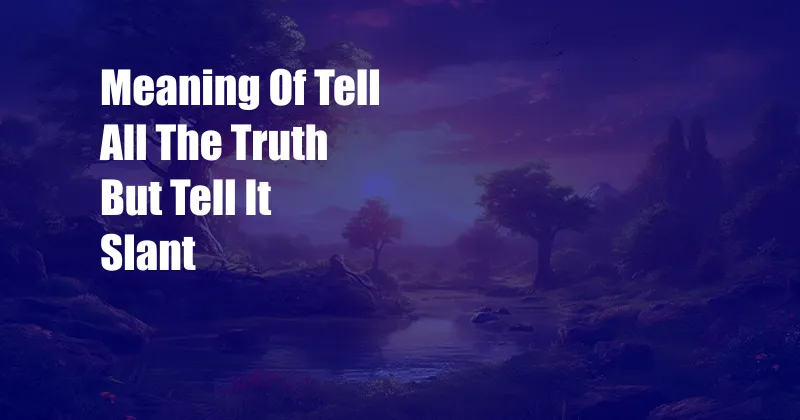
Tell All the Truth But Tell It Slant
In the realm of poetry, there lies a profound adage that has captivated readers for generations: “Tell all the truth but tell it slant.” This enigmatic phrase, coined by the esteemed poet Emily Dickinson, invites us on a literary expedition to unravel its multifaceted meaning and explore its relevance in our contemporary world.
The concept of telling the truth aslant suggests a delicate balance between honesty and nuance, between revealing the essence of a subject and casting it in a manner that allows for multiple interpretations. It is a subtle art that requires the poet to navigate the treacherous waters of candor and ambiguity, ultimately leading the reader to a deeper understanding of the subject matter.
The Art of Unveiling Truth Obliquely
The beauty of telling the truth slant lies in its ability to reveal hidden truths and evoke emotions that might otherwise remain dormant. By presenting truth in an oblique manner, poets invite readers to engage in active interpretation, leading to a more profound and personal connection with the subject. This approach allows for a greater exploration of the nuances and complexities of life, capturing the essence of human experience in all its multifaceted glory.
Moreover, telling the truth slant enables poets to challenge prevailing narratives and offer alternative perspectives. By presenting truth from an angle, poets can subvert expectations, question established norms, and provoke thought. This approach serves as a catalyst for critical thinking, encouraging readers to scrutinize their own beliefs and consider alternative viewpoints.
Historical Evolution and Modern Relevance
The concept of telling the truth slant has its roots in ancient storytelling traditions, where fables and parables were used to convey important truths through indirect and imaginative means. In modern times, this approach has found fertile ground in various artistic expressions, including poetry, literature, and even journalism.
In the digital age, where information is ubiquitous but authenticity is often elusive, the ability to tell the truth slant is more crucial than ever. By approaching truth from multifaceted angles, we can cut through the noise and uncover the deeper realities that shape our world. Whether it is through nuanced journalism that reveals hidden truths or artistic expression that provokes critical thinking, telling the truth slant remains a potent tool for understanding and navigating the complexities of the human experience.
Expert Insights and Practical Tips
Mastering the art of telling the truth slant requires a combination of skill, sensitivity, and a deep understanding of human nature. Here are expert tips to help you harness this technique in your writing and communication:
- Use metaphors and analogies: Drawing parallels between seemingly unrelated concepts can illuminate hidden truths and create lasting impressions.
- Employ sensory details: Engage the reader’s senses by using vivid language that appeals to sight, sound, smell, touch, and taste.
- Subvert expectations: Challenge conventional wisdom and offer alternative perspectives that prompt readers to think critically.
- Embrace ambiguity: Allow for multiple interpretations and avoid overly simplistic conclusions.
- Be mindful of your audience: Consider the background and beliefs of your readers to ensure that your message is received effectively.
By incorporating these tips into your writing, you can elevate the quality of your communication, fostering deeper connections with your audience and empowering them with a more nuanced understanding of the world.
Frequently Asked Questions
Q: What is the purpose of telling the truth slant?
A: To reveal hidden truths, provoke critical thinking, and present multifaceted perspectives.
Q: How can I tell the truth slant in my writing?
A: Use metaphors, analogies, sensory details, and subvert expectations while embracing ambiguity and considering your audience.
Q: Is telling the truth slant the same as lying?
A: No, it is a nuanced approach to truth-telling that presents truth from multiple angles without resorting to falsehood.
Conclusion
The adage “Tell all the truth but tell it slant” invites us on a captivating journey of discovery, encouraging us to embrace the subtleties and complexities of life. By engaging with this approach in our writing and communication, we can unveil hidden truths, challenge conventional wisdom, and empower our readers with a deeper understanding of the world around them. May we all strive to tell the truth slant, illuminating the path to a more nuanced and meaningful existence.
Are you captivated by the art of telling the truth slant? Would you like to explore further the nuances of this literary device and its applications in contemporary communication?